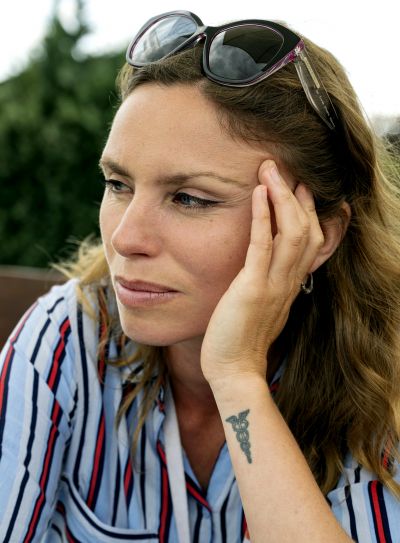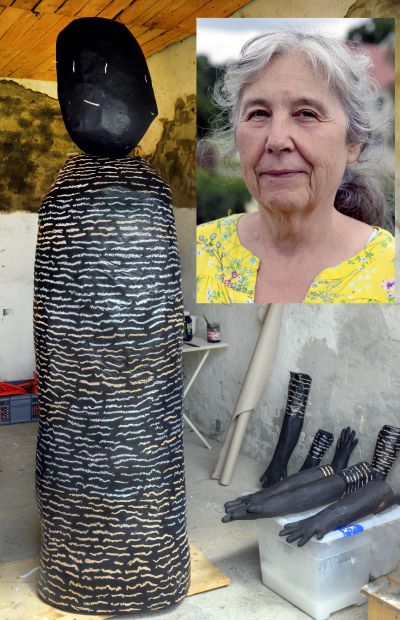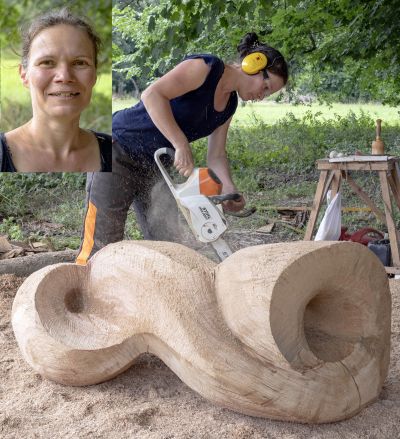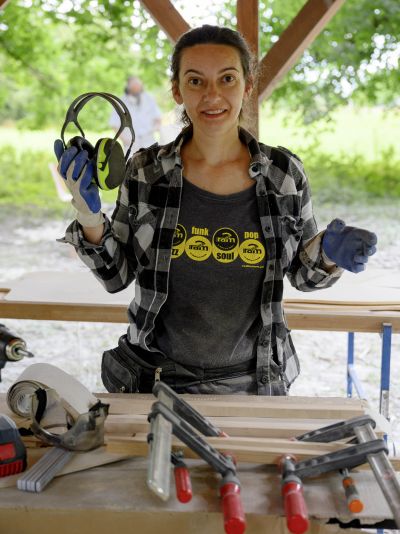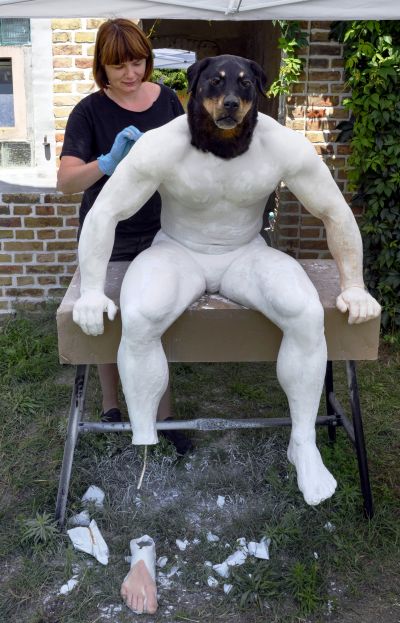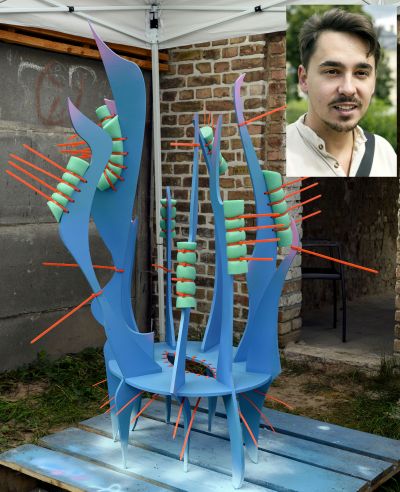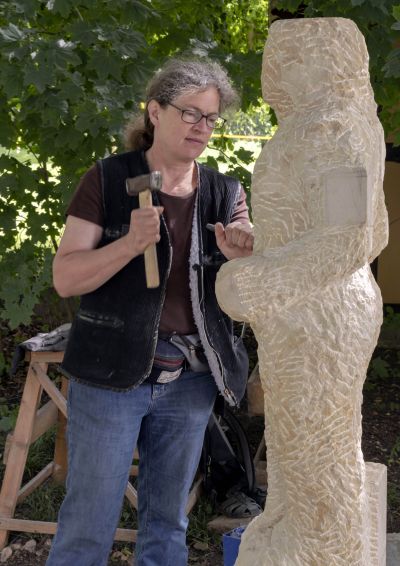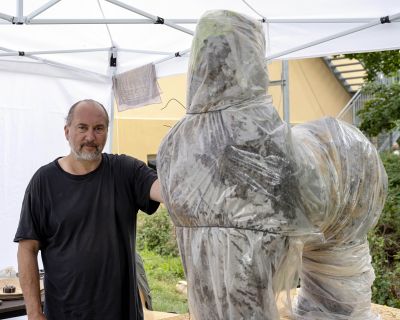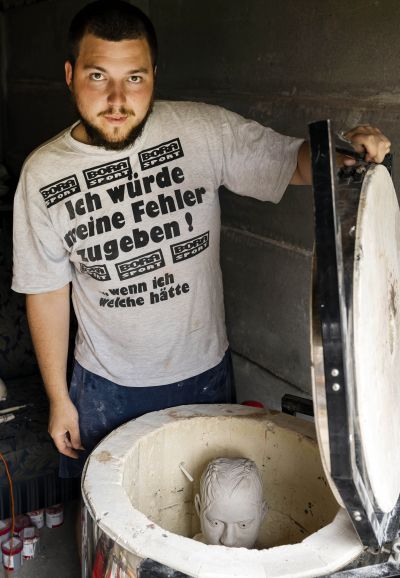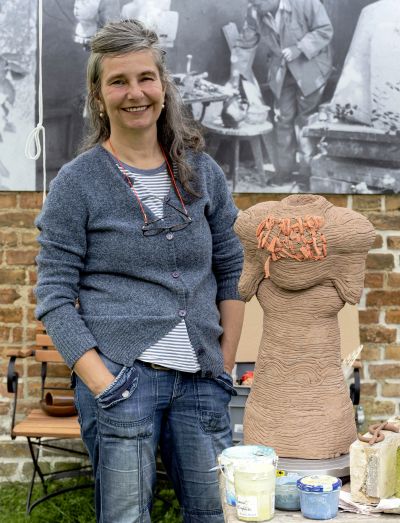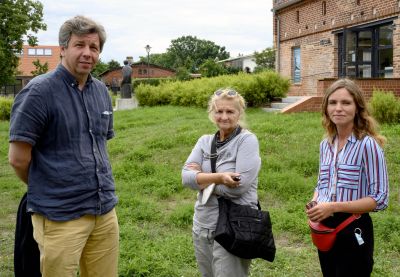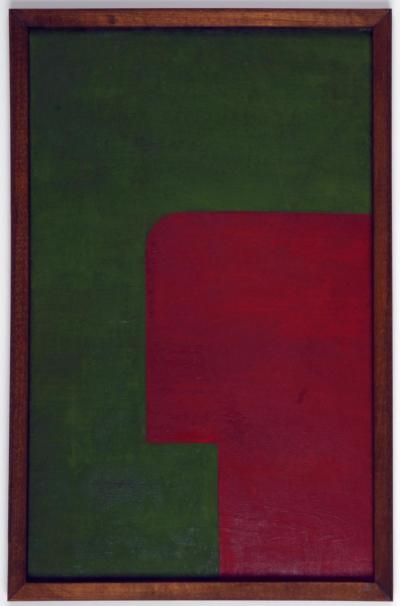THE ANCIENT WORLD – ROLE MODEL AND INSPIRATION? German-Polish open-air event for sculpted figures at Schloss Trebnitz from 28 July to 22 August 2021
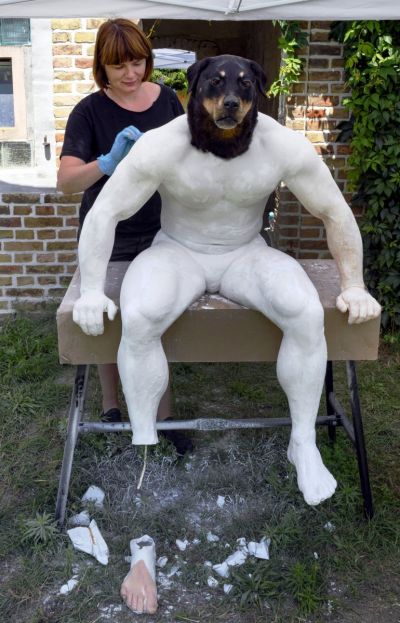
Beauty is in the proportions of the limbs, of one finger to another, of a finger to the wrist, to the palm of the hand and of all the limbs to one another.
Perfection depends on the many numerical ratios and is determined by the smallest deviations.
Polyklet
It is still unclear whether the Barbarian invasions destroyed the Roman Empire or whether its fall was due to the fact that the Empire had exhausted its potential. Nevertheless, Ancient Rome’s self-referral to Greece was unwavering so that its design language – whether consciously or unconsciously – has remained effective in art. The ancient world did not understand statues as objets d’art which possessed magical properties and fulfilled a function. The most important rule of the ancient canons related to the arrangement and the correct proportions of the works which were built on a square grid. The starting point for curator Marta Wróblewska and the artists present in Trebnitz is, above all, the development process of art which is explained by the multifaceted experience of crossing borders, an event which is combined with critical reflections and with the attempt to place the work in our context in order to reflect its historical origin. For this reason, the classic rules were called into question and experiments were carried out.
So what do the sculptural works of the 21st century tell us today in relation to the ancient canons and to the works from that era? Well, above all, they force a representation which has to gravitate towards the abstract because contemporary artists use many materials that were unknown in earlier times. The works are often created contrary to the formulae of figuration that were handed down, a fact that is mostly due to the new technical solutions and innovative spirit. Some artists referred to specific sculptural projects, others grappled with the creativity of Gustav Seitz. In doing so, it became clear that the need to express steadfast values grows whilst the sole reality today can only be described using the Bauman[1] term transience, which weakens our trust in ancient mythology. Permanent intersections of relationships and their infiltration, the focus on the creative process and the use of different forms and aesthetic categories of works, left room for many interpretations and provided the opportunity for comprehensive dialogues and to establish emotional ties with the observer, which the curator Marta Wróblewska sums up as follows: “Without crossing borders, there is no vitality in art.”
Hildegard Skowasch
Skowasch’s sculpture has the character of a totem. Her “blocky style” suggests that she has been inspired by mature archaism and by the majestic monuments of Gustav Seitz. The head of this figure follows the portrayals of the Roman god Janus, an old man with two faces, who can look forwards and backwards at the same time. Whilst we understand “Janus-faced” in political confrontations not just as two sides of a problem but also as contrary views, the original meaning referred to the power over heaven and earth, over the past and the future. The figure is made from papier mâché and is primed with the magnetic paint commonly used for school boards. The artist provided this surface with a personal letter code in which she communicates with the ancient world. This encrypted text is an intimate type of specific poetry. It is possibly an autodidactic linguistic form which allows Skowasch to assimilate the ancient world in stoic repetitions.
Ilka Raupach
Her fascination with the famous Laocoön group and her love of detail led the artist to concentrate on a curl in Laocoön’s mane of hair when creating her work. In the ancient world, hair was an expression of strength. In her analysis of this one element and the need to create an ideal form, the artist does not just attempt to control the difficult material – the ancient oak – she also enters into an alliance with the place at which the work is created. Her sculpture embodies the eternal “search for an unreal and indescribable object” (Ilka Raupach) and can be classified among the Land Art art movement.
[1] Zygmunt Bauman (1925-2017), Polish-British sociologist and philosopher.
Iwona Rozbiewska
The caryatids evolved as an art motif in the world of Ancient Greece and always portrayed women. They bore the load of structural ceilings, but were considered a decorative element in architecture. Rozbiewska was inspired by this and created a work that is both architectural and conceptual. Her caryatids are released from their role as servants to architecture. The lopsided construction and the use of less noble sheets of plywood, which were cut to size and reworked, suggest that the contemporary caryatids have become autonomous. At the same time, the current motifs of the MeToo women’s movement resonate in this work.
Monika Szpener
She is fascinated by hybrid beings of man and animal. The most famous example in the ancient world was the god of the dead Anubis, who looked like a dog and connected the world of the living with that of the dead. In the open-air workshop, the artist worked on a figure which ultimately took on a form in which perfection and imperfection meet, with Szpener referring directly to the sculpture “Geschlagener Catcher” (1966) by Gustav Seitz. She created a body imprint of a modern bodybuilder for which the ideal proportions of the ancient world served as a reference. The connection of the torso to a taxidermied head of a dog can be assessed here as flagrant breach of the ideals of the ancient world. The artist, who strives for perfection, experiments a lot, for example by looking for the perfect material to best reproduce the structure of human skin. This hyperrealistic work begs the question of just how far technical imitations can go, where their limits are and what consequences we have to anticipate if we decide to go beyond these boundaries.
Norbert Delman
Without exploring the intention and the symbolism of the artist, this work is to be understood as a negation of figuration. Inspired by the story of the mythological Medusa, the artist felt the need to think about violence against women and about its acceptance in the ancient world and today. With his aesthetic memorial that he dedicated to Medusa, the victim of a rape that was wrongly punished, he wants to atone for her for this dual sin. The mythological narrative of the violence is expressed by the tension between the materials. Particularly important here is the symbolism of water as a life-giving energy and of Medusa’s hair which is associated with female power and strength which restores the rightful place of the woman in society.
Robert Sarnecki
The human body has always preoccupied artists, even if the modern artists, who are inspired by the ancient world, are rediscovering the classical aesthetics for themselves. Sarnecki’s work was influenced by the most well known sculptural motif of the ancient world - the Kouros, the statue of an upright, naked young man with one leg in front, and his arms hanging by both sides of his body. Although the rigid pose of the body is not open and the face does not show any particular expression, the secretive smile is typical of this genre of art. Some researchers of antiquities believe that this uncertainty in the facial expression in the ancient world can be explained by the fact that the ancient sculptors were not yet able to reproduce different facial characteristics.
Roswitha Schaab
The Kouros formula that was taken up by the Egyptians also inspired this artist. She maintains the strict form of the figure, but concentrates on inscribing its surface. In this way, she creates a meticulous notebook containing personal reflections over the course of time, a type of intimate artistic legacy with which she imparts some key features of reality to posterity. Each touch of the chisel is planned by the sculptor and created so consciously that the next one is conditional upon it.
Ryszard Litwiniuk
The centaur symbolises the duality of human nature encountered half as a God and half as a beast. The torso of the hybrid being is like a human, the lower body was borrowed from a horse. The most well known representative in mythology was the wise and compassionate Chiron. Inspired by this hybrid figure, the artist turned his attention to a female form and referred to the oldest prehistoric sculpture of the Venus of Willendorf. His work is also inspired by the idea of the Trojan horse, which is to be understood here as a modern reference to the lurking danger of viruses. This work leans on the figure of the “Lauschenden” which was created by Gustav Seitz in 1968.
The artist duo Super Vivaz (Lina Baltruweit/Johannes Braunringer)
An ideal of the ancient Greeks existed in the Kalogathia, setting beauty on a par with goodness. In this sense, the deformation of the human body was associated with evil. Recreated in the style of the sculpture by Gustav Seitz entitled “Entwurf zur großen Danae”, which was produced in 1967, as well as classical representations of the odalisque, the white slave in the harem, the artist pair has created an idealised sculpture which is based on the present canon and which addresses luxury. The work, which is ready made, shows a figure on a chaise longue playing with a modern acquisition, a mobile phone, which has an app for processing photos with beauty filters. By criticising our excessive consumption, the artists ask how the barriers of good and evil, beauty and ugliness, truth and lie manifest in life and in art. They also encourage us to think about how these things have changed over time.
Susanne Ring
This sculpture is a group of objects made of clay, a material which dictates how the artist works because of the way it constantly changes. Susanne Ring exploits this property. The potter’s wheel came into being during the period to which the work refers which makes the classic form of an amphora a natural starting point for the artist. But her amphora are amorphous, they start to resonate with each other and multiply. The structure, which is developed consistently, is more pronounced and the form is constantly improved. But because there is no purely intellectual or purely intuitive art, the constant refining of the form is not Susanne Ring’s goal; instead it is a means that recalls the roll of the votive figure in the Early Archaic period, and a type of artistic meditation.
Magda Potorska, September 2021
